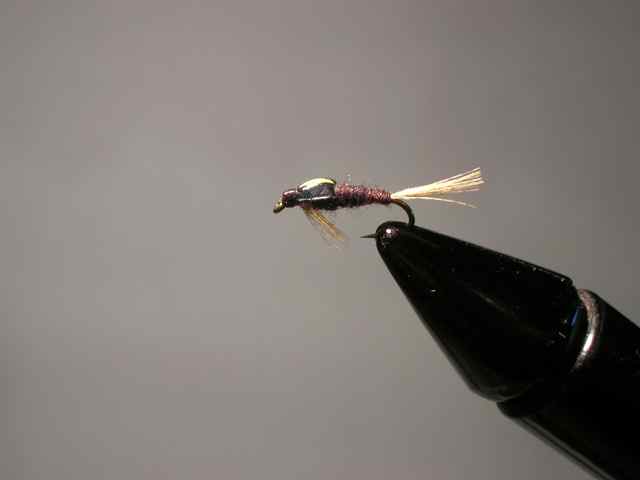Long Range Fish Report
From Sportfishing
From Sportfishing
Fish Report for 8-30-2013

Fly of the Week -- Split Back Sulphur Nymph
8-30-2013
Sportfishing Report Staff
On the recent CVTU Chapter trip to the South Holston River near Bristol, Tennessee, we observed several local fly fishers catching a good number of trout. The South Holston River is a tailwater and arguably the best tailwater fishing on the east coast. Upon questioning the fly fishers from the local area, I learned that the sulphur nymph they were using was a hybrid of the locally popular Copper Head and Split Wing Case nymphs. One of the fly fishers gave my wife, Gayle and me, several of the split back sulphur nymphs and we were impressed with the fishing results. The fishing technique was straight forward. Simply drop a single size 16, 18 or 20 Sulphur nymph near the bottom below a strike indicator. I had purchased the New Zealand Wool Indicator packet from the YBO fly shop prior to the trip and wanted to give it a try on the South Holston and it worked very well. I found that trout do not shy away from the wool indicator on the surface as can happen with foam and plastic indicators, especially in clear water. Another plus was the ability to adjust the wool indicator to varying water depths with ease. The combination of the wool indicator and sulphur nymphs that the local fly fishers so willing gave to us was a winning team. Unfortunately, the heavy rains in the South Holston River area and necessary water releases from the dam hindered our fishing time. I have since used the split back sulphur nymph on our Cumberland Valley waters and outside the area waters such as Penns Creek, Yellow Creek and Black Moshannon Creek with good results. Also, a friend of mine reported catching trout on the Letort Spring Run with the split back sulphur nymph that he tied.
RECIPE:
Hook: TMC 9300 Size 16-20
Bead: Black Tungsten Size 3/32-5/64
Thread: 8/0 Dark Brown
Tail: Lemon Dyed Mallard Flank Feather
Abdomen: Brown D-Rib or Dark Brown Muskrat Dubbing with Dark Monofilament Rib (Optional)
Thorax: Dark Brown Muskrat
Wing Case: 1/8" Black Scud Back
Split Back: Yellow Goose or Turkey Biot
Legs: Lemon Dyed Mallard Flank Feather
GENERAL TYING INSTRUCTIONS:
1) Pinch the barb before securing the hook in the vise jaws.
2) Insert tungsten bead and secure the hook in the vise. Attach the tying thread behind the bead and wrap over the hook shank to the hook bend.
3) Tie in the tail which should be approximately ?? length of hook shank.
4) Tie in the D-Rib material and wrap to within 1/3 of the bead, leaving space for dubbing. Result should be a pronounced segmented look.
5) Tie in goose or turkey biot just beyond mid shank from hook bend, leaving room for thorax dubbing.
6) Tie in scud back just in front of the biot, again, leaving room for thorax dubbing.
7) Dub thorax.
8) Cut a V notch in the flank feather and tie in the tips as legs.
9) Pull scud back material forward over thorax and legs and tie off behind bead.
10) Pull biot over scud back and wrap several times behind bead. Bend the biot back and add a few more wraps, then cut tag end. The extra wraps add durability to biot tie in location.
11) Cover the top of thorax area with glue of your choice for durability and nice sheen appearance.
Credit: This information was from:
Four Seasons Flyfishing Guide Service
Carlisle, PA 17013
717-713-8282
Hook: TMC 9300 Size 16-20
Bead: Black Tungsten Size 3/32-5/64
Thread: 8/0 Dark Brown
Tail: Lemon Dyed Mallard Flank Feather
Abdomen: Brown D-Rib or Dark Brown Muskrat Dubbing with Dark Monofilament Rib (Optional)
Thorax: Dark Brown Muskrat
Wing Case: 1/8" Black Scud Back
Split Back: Yellow Goose or Turkey Biot
Legs: Lemon Dyed Mallard Flank Feather
GENERAL TYING INSTRUCTIONS:
1) Pinch the barb before securing the hook in the vise jaws.
2) Insert tungsten bead and secure the hook in the vise. Attach the tying thread behind the bead and wrap over the hook shank to the hook bend.
3) Tie in the tail which should be approximately ?? length of hook shank.
4) Tie in the D-Rib material and wrap to within 1/3 of the bead, leaving space for dubbing. Result should be a pronounced segmented look.
5) Tie in goose or turkey biot just beyond mid shank from hook bend, leaving room for thorax dubbing.
6) Tie in scud back just in front of the biot, again, leaving room for thorax dubbing.
7) Dub thorax.
8) Cut a V notch in the flank feather and tie in the tips as legs.
9) Pull scud back material forward over thorax and legs and tie off behind bead.
10) Pull biot over scud back and wrap several times behind bead. Bend the biot back and add a few more wraps, then cut tag end. The extra wraps add durability to biot tie in location.
11) Cover the top of thorax area with glue of your choice for durability and nice sheen appearance.
Credit: This information was from:
Four Seasons Flyfishing Guide Service
Carlisle, PA 17013
717-713-8282
< Previous Report Next Report >
More Reports

8-29-2013
by Ron Newman Is there really a "Kamloops Trout"? A trout that is distinct and different from other Rainbow Trout? Surprisingly...... Read More
SportfishingReport Reports
for Wednesday, August 28th, 2013• 2013 International Fly Fishing Fair

LongRangeSportfishing.net © 2025. All Rights Reserved.
Website Hosting and Design provided by TECK.net
Website Hosting and Design provided by TECK.net